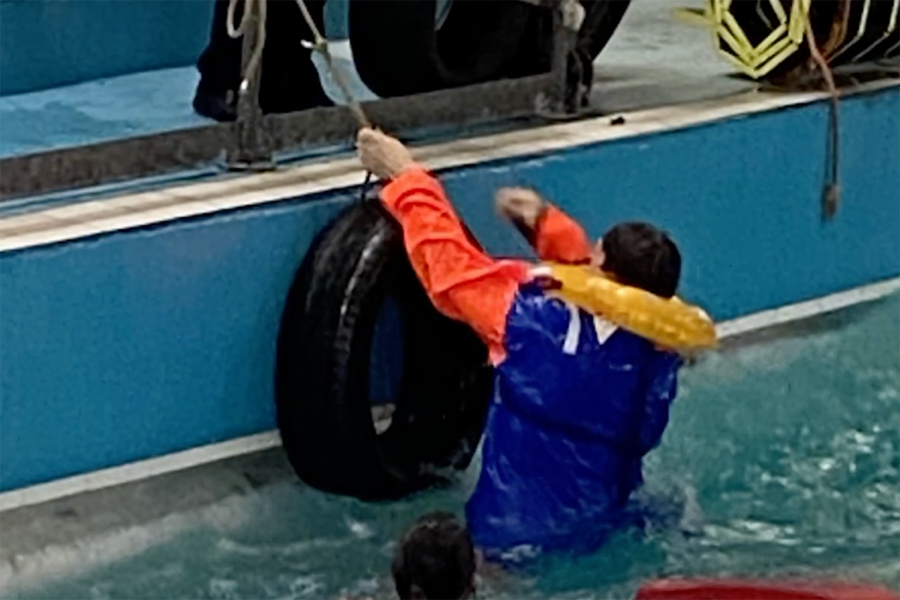Over the past six months, the MAIB has launched new investigations into several fatal accidents onboard fishing vessels. The organisation says it has identified various recurrent themes, but man-overboard retrieval remains a persistent, and deadly, issue.
In light of this, inspector of marine accidents at the MAIB Jack Martin took part in a man-overboard exercise organised by the RNLI and funded by Trinity House and Seafish.
For the exercise, participants were immersed in a wave pool to gain an understanding of what fishermen falling overboard would experience.
Jack Martin shares his experience of the man-overboard exercise.
What happened during the training?
“We were joined by a group of fishers from the east coast fleet who were all working onboard 8m or 9m crab and lobster potters that launch from beaches. The morning involved some honest conversations about lifejacket use and their experiences of accidents.
“It was fascinating to hear the perceived issues with wearing lifejackets while working on their boats. Once Frankie Horne, our trainer, had shown them the statistics around man-overboard incidents and the effects of cold water immersion, some of the reasons given for not wearing lifejackets (like comfort and convenience) seemed trivial, and the fishers fully admitted that.
“In the afternoon, the real learning started! The fishers got changed into the clothes they would normally wear out at sea. We then added a set of overalls and then oilskins and shoes or boots. The first task was to jump into the wave pool and tread water for as long as we could. Then we went back in with an auto-inflate lifejacket with 150N of buoyancy to compare the experience. With the lifejackets on, we then had the chance to try out some different types of recovery equipment.”
What did you experience in the tank?
“I’ve always thought I was a decent swimmer, but what was immediately noticeable was the weight of the oilskins. Although working hard, I felt okay for the first couple of minutes, chatting with the lifeguard and keeping a rhythm with the up and down of the waves, but that changed very quickly.
“As soon as the first significant splash of water went over my face, I started to go downhill rapidly. Every time I tried to calm myself down and get my breathing under control, another wave would hit, and I felt more and more desperate for a decent breath of air. Any rhythm I had with the waves disappeared, which then compounded the issue as it seemed every wave was now breaking over my head.
“The reality dawned on me; I was drowning. I signalled to the lifeguard who rescued me, and when I finally got out of the pool, I was completely exhausted. I had been in the wave pool for just five and a half minutes.
“When in the pool with the lifejacket on and inflated, I was so much more comfortable. Although I still got the occasional splash over the face, I could float calmly and preserve my energy. What was very noticeable was the difference in comfort and how high my head was above the water when my crotch strap was tightened properly.”
What made it so challenging to keep going?
“The weight of the oilskins was like having an anchor tied around my waist. I was also very aware that I was in a heated swimming pool with a lifeguard less than 1m away at all times, so I tried to imagine myself in freezing water, alone and with no way to raise an alarm. It was genuinely terrifying.”
What was the key piece of safety learning you came away with?
“It’s really important to see man-overboard recovery as a system of several parts. Start by trying to eliminate the risk of going overboard in the first place, of course. However, if someone is in the water, you have to assume that, in most cases, they will be unable to help in their own rescue after around 10 minutes due to the effects of immersion in cold water.
“A lifejacket will give time to affect a rescue, but only if there is a well-considered recovery system in place which is ready to use. Being well drilled in the use of the recovery equipment is also critical to a successful rescue, as is the ability to raise an alarm, like the use of a personal locater beacon, especially on single- handed vessels.”
What advice would you give to someone who finds themself or a colleague in a similar situation in real life?
“Don’t be in that situation! Even in a heated pool, without a lifejacket the danger of drowning was very real when fully clothed and with a 1m wave state. When you consider the temperature of the waters around the UK and Ireland, a properly worn lifejacket could make the difference between going home to your family that evening or dying – and I think that’s the real point.
“Wear the lifejacket for your crew, to give them time to rescue their mate and not have to watch you die unnecessarily. Wear it for your family, who want you back safe and sound. Don’t be selfish – wear your lifejacket.”
You can watch the video showing Jack’s experience in the tank below…
This story was taken from the latest issue of Fishing News. For more up-to-date and in-depth reports on the UK and Irish commercial fishing sector, subscribe to Fishing News here or buy the latest single issue for just £3.30 here.








